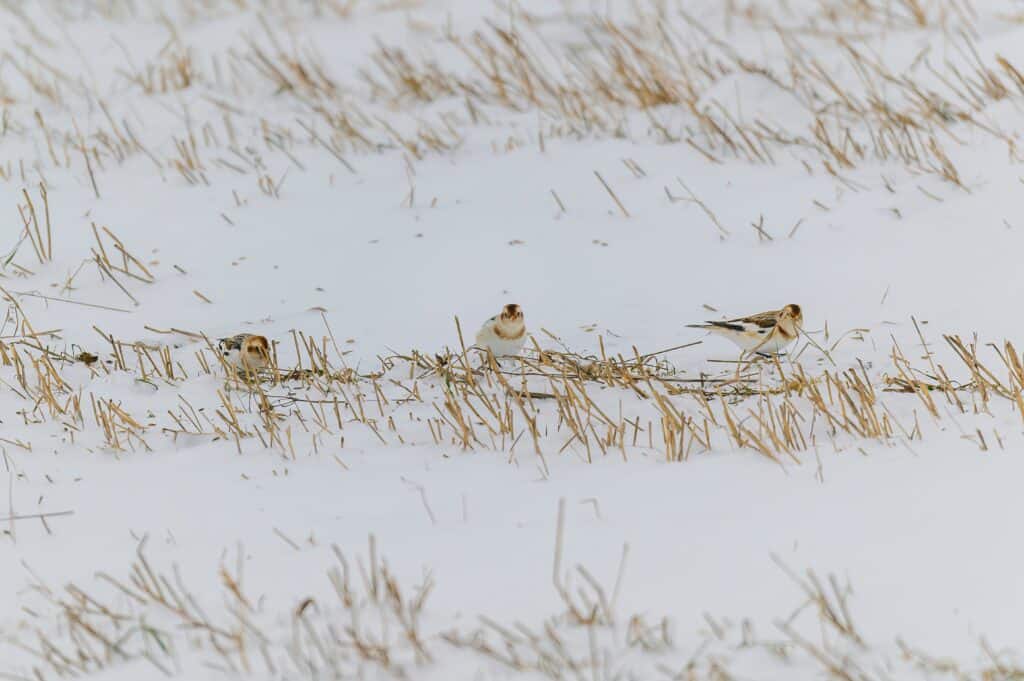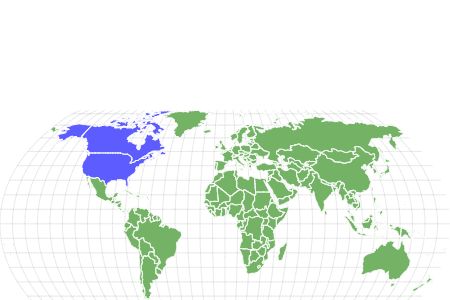Snow Bunting
P. nivalis
Advertisement
Snow Bunting Scientific Classification
- Kingdom
- Animalia
- Phylum
- Chordata
- Class
- Aves
- Order
- Passeriformes
- Family
- Calcariidae
- Genus
- Plectrophenax
- Scientific Name
- P. nivalis
Read our Complete Guide to Classification of Animals.
Snow Bunting Conservation Status
Snow Bunting Facts
- Group Behavior
- Solitary/Pairs
- Estimated Population Size
- 29 million
- Biggest Threat
- loss of habitat to climate warming
- Wingspan
- 32-38 cm
- Incubation Period
- 10-16 days
- Habitat
- Open fields, shorelines, roadsides
- Predators
- Arctic Foxes, Snowy Owls, Falcons, Skuas
- Diet
- Omnivore
- Nesting Location
- Rocky areas and boulder fields
- Migratory
- 1
Snow Bunting Physical Characteristics
- Color
- Brown
- Black
- White
- Skin Type
- Feathers
- Lifespan
- Up to 9 years
- Weight
- 1.5 ounces
- Length
- 6.5-7.5 inches
- Age of Sexual Maturity
- 1 year
- Venomous
- No
- Aggression
- Low
View all of the Snow Bunting images!
Snow buntings are birds that live in the very far north of the Americas, only coming down to southern Canada during the winter months. They live in small groups and nest in small cracks within mountainous regions.
They’re well known for their white plumage and beautiful wing feathers. These restless birds can never stay still during the winter, making them not too difficult to spot.
3 Amazing Snow Bunting Facts
- The oldest snow bunting on record was 8 years and 9 months old. He was recaptured and re-released during banding operations in Alaska, the same state where he had been banded.
- Breeding and non-breeding snow bunting look different. Breeding bunting have more white plumage, though this is not caused by growing a new set of feathers. Actually, the snow bunting will rub its chest plumage on the snow until the brown parts of the feather have worn down to show the shorter, white feathers.
- Males can be found at the Arctic breeding grounds even during the winter, when temperatures can dip as far as -22° F. The ground is still extensively covered in snow. This may seem way too early for the males. They actually need to begin making a nest fairly early to ensure they get a good spot due to there not being many spaces.
Where to Find the Snow Bunting
Snow buntings can best be found during the winter, as they migrate further south. They are found in the high Arctic tundra of North America, Ellesmere Island, and Iceland. In some areas, it is found in colder, more mountainous regions, such as Scotland, Norway, Russia, Northern Greenland, Siberia, Novaya Zemlya, and Franz Josef Land.
These birds can commonly be found on the ground in fields or next to bodies of water where foliage for nests is greater in numbers. They can be hard to spot due to their white plumage, but if you carefully scan the ground and wait for a moment, you might be able to spot one.
Also, they are very restless during this time, making them easier to spot if you’re willing to wait for a flock of them to fly to a new spot.
Snow Bunting Nests
Males arrive on breeding grounds 3-6 weeks before females to stake out territories containing suitable nest sites. The nest site is in a protected cavity, as in a deep fissure among rocks, sometimes under man-made debris, or in a hole in the ground.
The females build the nests out of grass and moss. It’s lined with grass, rootlets, plant down, and lots of feathers and hair.
Snow Bunting Scientific Name
The snow bunting’s scientific name is Plectrophenax nivalis. There are four different subspecies, which differ slightly depending on geographical location. However, interbreeding does happen due to migration paths crossing.
Plectrophenax nivalis, the snow bunting’s scientific name, comes from the Greek word plektron. It means a claw-like tool for striking the lyre, in this case referring to the snow bunting’s long, straight hind claw.
Phenax is Greek for false, because the claw isn’t really used to play the lyre. Finally, Nivalis is the Latin word for snowy, which refers to the bird’s color and Arctic home.
Snow Bunting Size, Appearance, and Behavior
The snow bunting is known for its white and black plumage. The white allows it to camouflage itself in the snowy environment it lives in. This species is often confused with the McKay’s bunting (Plectrophenax hyperboreus) due to the similar coloration of their plumage.
The wingspan of this small bird is 32-38 centimeters, with a length of 15 centimeters, making it truly a tiny bird. These birds generally weigh about 30 to 40 grams.
Both the female and male snow buntings look different, making this species sexually dimorphic, meaning the plumage depends on sex. During the breeding season, the male is white with black wingtips and a black back. The female has black wingtips and a rufous back.
During the winter, they will both have a rufous coloration in the back. Unlike most passerines, it has a feathered tarsi, adapting it to its harsh, cold environment. This allows it to endure winter much longer in the northern regions, unlike the rest of the passerine. The only exception to this is the common raven.

Snow Buntings blend in well with a winter background, giving them protection from predators.
©James W. Thompson/Shutterstock.com
Snow Bunting Migration Pattern and Timing
Snow buntings tend to migrate mostly late in the fall and early in the spring. Strays south of the main winter range may be most likely to appear in November. They are known for being the first species to migrate to the Arctic to reproduce.
In the beginning, the males arrive first. Usually, they arrive in April, though the temperature can still be −22 degrees Fahrenheit at this time. This early migration can be explained by knowing that this species is extremely territorial. Getting good nesting territories is vital for nest success, which is why the males migrate so early.
When migrating, flocks can easily reach the hundreds.
When they leave the Arctic varies. Some of them will leave around the end of September, while others will migrate in November. During this time, the females will leave first. Usually, females spend more time in the southern territories.
The juveniles stay in the Arctic and gather their strength for the journey. Therefore, they spend a lot more time in the Artic than the adults.
Snow Bunting Diet
Snow buntings change their diet throughout the year to reflect the changing seasons. They will eat a variety of seeds, weeds, and bugs.
What Does Snow Bunting Eat?
Snow buntings eat a variety of seeds in the spring and fall. The birds will consume seeds directly off the ground and off of low-hanging stems. In the summer, they tend to pick seeds directly off the plants before they drop.
During the summer, they eat more invertebrates, including butterflies, true bugs, flies, wasps, and spiders. However, they still eat many plant seeds
Snow Bunting Predators, Threats, and Conservation Status
There are currently no efforts to conserve and protect the snow buntings, as they are of least concern according to the encyclopedia of life. However, climate change is causing concern over what will happen to the habitats of these natively Arctic birds. The warming of the planet could cause these birds to migrate less to the south each year.
Climate change is thought to be the direct cause of the number of their population decreasing in North America.
What Eats Snow Bunting?
Snow Buntings are prey for Arctic Foxes, Snowy Owls, Falcons, and Skuas (Jaegers).
Arctic foxes are known for easily blending in with their environment and pouncing on prey. Snowy owls are very similar to Arctic foxes in that regard. Falcons tend to fly very high before diving and grabbing at the prey, easily killing it on impact.
Skuas attack mid-flight, usually attacking other kinds of large birds to steal their kill, which can include snow bunting.
Reproduction, Young, and Molting
Snow bunting lay 4-7 eggs, and sometimes 2-9. Incubation is by the female for 10-16 days. In some parts of the range, the male feeds the female on the nest throughout the incubation period, allowing her to spend more time on eggs, which is very important in cold northern climates.
The young snow buntings are fed by both parents, and leave the nest about 10-17 days after hatching. There is only one brood of eggs per year. Snow buntings always molt once a year.
Population
Snow buntings are currently common, and Partners in Flight estimates that the global breeding population is 29 million.
However, while there is no concern nor current conservation efforts, the population is slowly declining, having declined 28% in 44 years.
View all 293 animals that start with SSnow Bunting FAQs (Frequently Asked Questions)
Does the snow bunting migrate?
Yes, the snow bunting migrates once a year.
How many eggs does the snow bunting lay?
The snow bunting will lay 3-7 eggs and sometimes 2-9.
How fast does the snow bunting fly?
The snow bunting’s maximum speed is around 45 kilometers per hour.
What is the snow bunting’s wingspan?
The wingspan of the snow bunting is 28-32 centimeters.
When do snow buntings leave the nest?
Juvenile snow buntings will leave the nest around 10-17 days after hatching.
Thank you for reading! Have some feedback for us? Contact the AZ Animals editorial team.
Sources
- Wikipedia, Available here: https://en.wikipedia.org/wiki/Snow_bunting
- RSPB, Available here: https://www.rspb.org.uk/birds-and-wildlife/wildlife-guides/bird-a-z/snow-bunting/
- Wildlife Trusts, Available here: https://www.wildlifetrusts.org/wildlife-explorer/birds/finches-and-buntings/snow-bunting

















